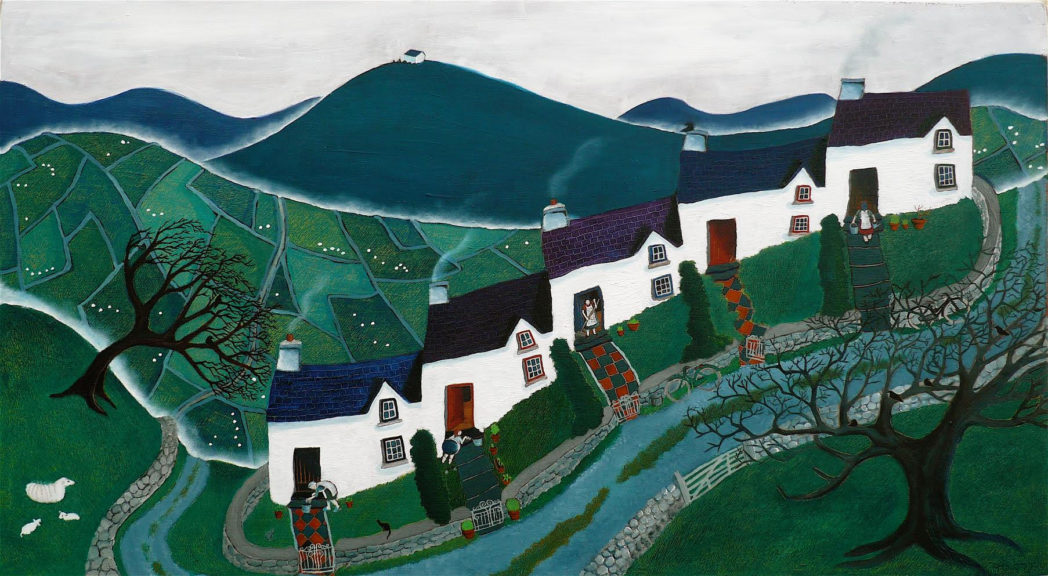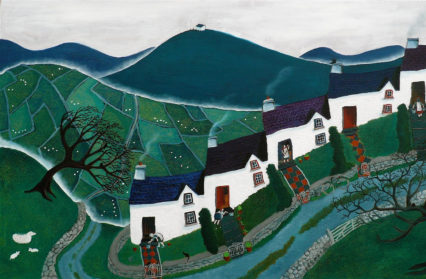In the latest in our series looking at the breakthrough work of artists, French-Quebecker artists Valériane Leblond opens up about her attachment to the Welsh landscape, her technique, and her development as an artist.

Valériane Leblond: I painted this picture in 2008 for the annual summer open exhibition in Machynlleth. The theme was « y cam nesaf », « the next step », and I chose to depict it both figuratively and metaphorically.
I did several sketches and gathered a lot of different ideas before I thought that women cleaning their thresholds would be an interesting way of developing the theme. I also wanted to suggest (indirectly, without being too heavy) that we don’t know what is next, what comes after life, and that we can really only concentrate on day-to-day occupations.
I painted this less than a year after coming from France to live here with my Welsh boyfriend. I feel the ‘mal du pays’, the hiraeth for my homeland, every day – but it was much stronger back then, when I didn’t have a family of my own here, and I had to learn to adapt, to speak a new language and meet new people. It was very comforting to see that the rural way of life here is not very different from the one back home, and that the same values predominate: the pride taken in simple things and the dignity of certain occupations. I have only lived in France and Wales, but I am sure I would find these connections and similarities in other places in Europe, and probably all around the globe.
In that painting I started from a fictional location, one that you could place in Wales, with its traditional architecture and picturesque landscape, to touch on something more universal about life, space and time. My artworks often deal with the idea of belonging, how people inhabit the land, what makes the place they call home. There is a strong element of the past in my paintings, but they are not trying to be historically ‘accurate’. I read a lot and use many references, but I want them to be imaginary. I want to recreate a nostalgic place and time that I have in mind: a place that might come from childhood memories, novels and poems that I have read, stories people told me… and I try to take you there as well. I hope it works.
With « Gwragedd ar eu trothwyau », I found the balance I was looking for. Within a limited palette, I captured the light and contrasts I wanted and the mood I was aiming for. People say that there is something calming, soothing, about my paintings. Most of them are painted with oil on wood. It dries slowly so it gives me all the time I need to work at my own pace. With oil if you want a tidy result you have to think in advance and take your time; it gets messy very easily, and it is difficult to correct mistakes.
This painting represents a turning point for me, because for once I was completely satisfied with what I painted, and didn’t think it could have been better done a different way. I’m not really a perfectionist— I know where to stop when I paint. But I keep a rather critical eye on what I do, and I can always see what could have been done better (I don’t hang my artworks at home because I would notice all the things that are wrong with them!) I also think that artworks should be able to fly the nest and start a new life somewhere else, in someone else’s eyes.
A lot of the elements used in this painting are the same as I use now: the hills and bent over trees, the whitewashed cottages, the women at work, and all the details and sub-stories that you may notice if you look longer. I love reading novels and I wanted to be a writer when I was a child. There is a narrative aspect in my paintings, and I often have to write down what I have in mind before I start to paint it.
There is a story behind most of my pictures, but I want to leave the door open to viewers to add their own interpretations and let their own feelings rise to the surface. I don’t want to deliver a message with my artworks, but I do hope to strike an emotional chord in the spectator, something that echoes to their own stories.
When I look at this painting now, I still feel that sort of longing, that nostalgia, that takes me sometimes.
– Valériane Leblond
Karen Ingham is an interdisciplinary artist-designer and filmmaker. She gained an MPhil and a PhD with the University of Wales for her research into historical and contemporary art and science collaborations in the biomedical domain.












